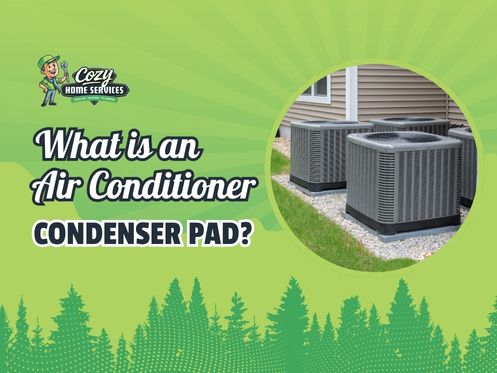Summary at a Glance
- A condenser pad supports your outdoor AC unit and protects it from external moisture, pests, and vibrational damage.
- Quality pads that are made from composite materials or concrete can last 15 to 20 years when properly installed.
- An unlevel pad reduces your system’s efficiency and can lead to expensive repairs.
Your outdoor AC unit rests on a level surface called an air conditioner condenser pad, which protects it from damaging moisture, dirt, and vibration. Installing a condenser pad helps prevent excess wear and tear and extend your AC unit’s lifespan. Find out how Cozy Home Services can help you choose and install the right AC condenser pad for your home.
What Exactly Does a Condenser Pad Do?
Just as your home needs a foundation to rest on, your AC needs one too. A condenser pad serves as a level surface for your AC to rest on, acting as a barrier between the unit and the ground, and as a vibration damper. Your AC vibrates when it runs, and a good condenser pad for an air conditioner helps absorb some of that vibration to combat wear and tear.
Why Your AC Condenser Pad Matters More Than You Think
An AC condenser pad helps keep your AC working safely and efficiently. Here’s why your AC condenser matters:
- An outdoor AC unit placed directly on the ground could sink or tilt, and the refrigerant inside may pool in the wrong places. A condenser pad keeps it safe and level.
- Without a condenser pad, rainwater can build up around and under your unit, potentially causing electrical problems.
- A pad raises your unit off the ground, protecting it from pests, moisture, and dirt.
What Are AC Condenser Pads Made Of?
There are three types of AC condenser pads — concrete, plastic, and composite. Each has its own benefits and disadvantages:
- Concrete condenser pads: These pads are tough and durable, and can last up to 20 years if poured correctly. However, they’re heavy and can crack over time, requiring replacement.
- Plastic condenser pads: Plastic is the cheapest option, but it’s much less durable than concrete. In hot California summers, plastic can also warp and crack faster than other materials.
- Composite condenser pads: These pads have become a popular choice because they’re made from recycled materials like rubber, and they’re tougher than plastic but lighter than concrete. They’re also easier to install and provide excellent dampening.
How To Choose the Right Condenser Pad for Your Home
The condenser pad should be at least inches longer than the edges of your AC unit, which prevents the unit from hanging as it settles. The proper size for an AC condenser pad varies depending on the AC you choose. Larger units need larger pads.
As for materials, opt for a concrete or highly durable composite pad for greater longevity. If you’re working on a budget, a cheaper composite pad is better than a plastic one.
Also, consider your outdoor conditions. If your backyard has uneven ground or a lot of dirt, you’ll need a larger pad to distribute the AC unit’s weight evenly.
Can I Install a Condenser Pad Myself?
Installing a condenser pad is best left to professional, highly-rated HVAC technicians. Incorrectly installing a condenser pad can result in an inefficient AC unit and even contribute to an unexpected, costly breakdown. The pad needs to be perfectly level in all directions because even a slight tilt can cause problems down the road.
The trickiest part is disconnecting and reconnecting the refrigerant lines if you need to lift the air conditioner onto the pad. This requires the skill and experience of a licensed AC technician.
When Should You Replace Your AC Condenser Pad?
Replace your AC condenser pad when you notice these warning signs:
- Visible cracks, especially if they go through the whole pad
- Water pooling, which usually means the pad is not installed properly for drainage
- Tilting or visible gaps between the pad and the AC unit
- Crumbling pad edges
- Visible signs of rust on the bottom of your unit’s condenser
Can a Poor Condenser Pad Affect My System’s Efficiency?
A condenser pad is one of the components that can make or break your unit’s efficiency. When your AC unit isn’t level, your refrigerant doesn’t flow properly through the system. Your compressor must work harder to move the refrigerant that pools in the wrong places. This means reduced energy efficiency and a higher utility bill.
The benefit of an AC condenser pad is that it creates an environment that helps your unit run smoothly. Limited vibrations allow the AC to operate properly between cycles, reducing mechanical stress. A working pad also keeps moisture and rust away, while a poor one won’t.
Scheduling regular maintenance for your AC unit lets you know if your condenser pad is doing its job correctly. The best time to schedule tune-ups is during the off-season, which is in the fall for air conditioners.
Flexible HVAC Financing Options
Cozy Home Services understands that HVAC repairs and upgrades can be hard on the budget. That’s why we offer various financing options to help with costs. Whether you need a simple condenser pad replacement or a complete system upgrade, we can work with you to find a payment plan that suits your needs.
Service Areas We Cover
Cozy Home Services proudly serves homeowners throughout:
- Brentwood, CA — 90049
- Rio Vista, CA — 94571
- Vacaville, CA — 95688
- Suisun City, CA — 94585
- Fairfield, CA — 94533
Protect Your Comfort from the Ground Up
Your condenser pad plays a key part in your AC’s lifespan and efficiency. If you’re not sure about the condition of your current pad and need condenser pad servicing, or if you’re installing a new system and want to ensure it’s level and protected from the elements, contact Cozy Home Services to schedule an appointment.
Frequently Asked Questions
How high should the condenser pad be off the ground?
Your condenser pad should be around two to four inches off the ground to keep your unit away from water, mud, and debris. Most residential condenser pads are two to three inches in thickness.
How much does condenser pad installation cost?
Costs vary based on material, size, and site conditions. However, a condenser pad is a small investment compared to the cost of repairing or replacing an AC condenser damaged by a poor foundation.
Do I need to put gravel under my condenser pad?
Yes. We recommend placing two to four inches of compacted gravel under your pad. This improves drainage, prevents settling, and creates a more stable base for your AC unit.
Can tree roots damage my condenser pad?
Yes. Large tree roots growing under your condenser pad can cause it to crack or tilt. The best thing to do is keep your condenser at least three to four feet away from large trees.
Why should I go with Cozy Home Services for condenser pad installations?
Our licensed and insured HVAC technicians have been expertly installing condenser pads in California for several years. They can help you choose the right size and material for optimal protection of your AC unit.


